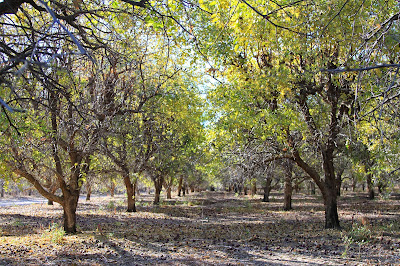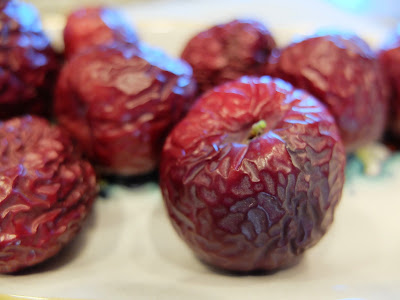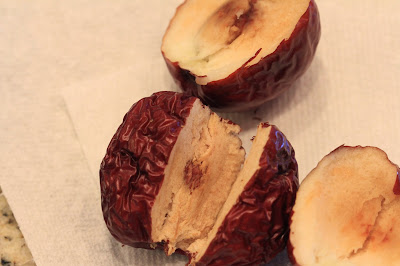Left: Fleshy Jujube; Right: Shriveled Jujube
While other folks were snapping up black Friday deals, Travelmarx was jeeping around the north end of the Imperial Valley (Slabs, All American Canal, Mammoth Wash). Riding around the edge of this agricultural/desert region is like listening to a Philip Glass piece. You see dry desert – mesquite and ironwood – for a long time; that’s the note in a Glass piece that seems to go on forever. And then suddenly, you come upon an unexpected, lush citrus grove; the note changed and you are excited for the new sound because the tension is relieved. And so it was as we were coming out of Mammoth Wash (33°07'40.0"N 115°22'19.6"W) and we spotted citrus groves. But even better - like a third note in our Glass piece - we saw a grove of something very different from citrus. We stopped to take a look. What we found were deciduous trees with strange fruit that looks like a small apple, except with a pit. The ground was littered with reddish, shriveled up fruit. We sampled the them and they tasted like a combination of a date and honey. Very tasty.
After a little research back at the ranch (literally), we found that we had come across jujube, Ziziphus jujuba, a member of the Buckthorn family. They are commonly called red dates, Chinese dates, Korean dates, or Indian dates – all containing the word “date” alluding to their taste. While they have been grown in China for thousands of years, they were only introduced into the US in the late 1800s. According to FoodFacts, the initial introductions to the US were varieties meant for drying and the public was was more interested in fresh fruit.
We picked up a dozen or so of the desiccated jujube from the ground, brought them home, and enjoyed them over the course of the holiday weekend. The taste continued to grow on us. We don’t have a clue as to the cultivar we found. The California Rare Fruit Growers page for jujube lists a number of common cultivars.
Some more jujube references: A Brand-New, 4,000-Year-Old Fruit, Jujube – A Fruit Well Adapted to Texas, and Hardy Tree Yields ‘Chinese Dates’. In Italian, they are called giuggolo (plural giuggole). The Italian Wikipedia entry brodo di giuggiole talks about the phrase andare in brodo di giuggole, which roughly means being in rapture from consuming this fruit. It’s that good.
Left: Jujube Trees Near Mammoth Wash; Right: Dried Jujube Fruit
Left: Cutting Open a Jujube Fruit and Seeing Pit; Right: Dried Jujube Fruit
%2Bon%2Bthe%2Btree.JPG)
%2Bon%2Bthe%2Btree.JPG)




No comments:
Post a Comment
All comments are moderated. If your comment doesn't appear right away, it was likely accepted. Check back in a day if you asked a question.